Designing the World's Largest Wind-Wave Research Facility
Advancements underway in planning the full-scale NSF-NICHE laboratory
Published on September 16, 2024
More than any other research community, natural hazards engineers and scientists apprehend the physical and societal effects of a changing climate. Along the Atlantic and Gulf coasts, hurricanes and associated storm surge and flooding increasingly threaten infrastructure; in the nation’s interior, tornadoes and derechos pose increasing risks. Every year in the U.S., windstorms alone kill hundreds of people and, on average, cause $80B in losses.
In 2022, the U.S. National Science Foundation awarded a $12.8M planning grant, through the Mid-Scale Research Infrastructure (MsRI) program, to design a facility called the National Full-Scale Testing Infrastructure for Community Hardening in Extreme Wind, Surge, and Wave Events. Known as the NICHE facility, this ambitious project addresses a national research need for high-intensity and up to full-scale simulation of extreme winds combined with wave action and storm surge to examine impacts on natural and constructed systems.
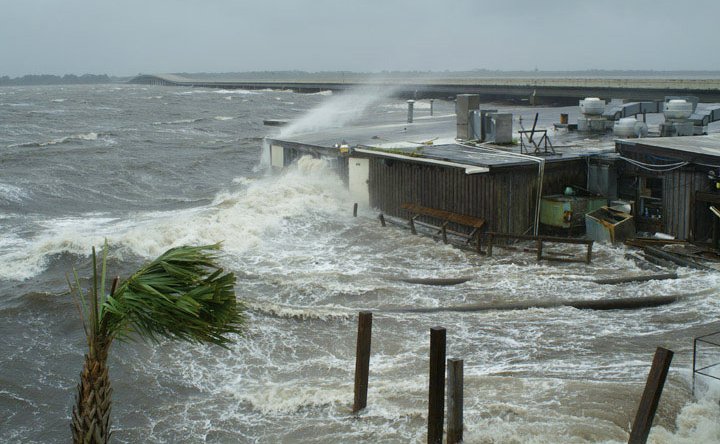
(Image: USGS)
Although part of the NSF-funded Natural Hazards Engineering Research Infrastructure (NHERI) program, the NICHE planning award (#2131961) has its own source of NSF funding, distinct and separate from NHERI.
About NICHE
The planned NICHE multi-hazard laboratory will be focused on the study of extreme wind, waves, and surge on civil infrastructure, the natural environment, and communities affected by natural hazards.
“With data from such large-scale tests, and at such high-intensities, researchers will gain vital understanding necessary to solve the large-scale problems facing so many communities,” said Arindam Chowdhury, principal investigator for NICHE. “With this facility, we can help coastal populations build resilience and thrive sustainably. The benefits of these NICHE-enabled impacts vastly outweigh its construction and operational costs, especially in view of climate-intensifying hazards.”
Researchers at NICHE will conduct high-fidelity investigations in three key areas:
- Community Hazard Modeling and Resilience under Combined Hazards
- Coastal Processes Modeling and Mitigation under Interacting Hazards
- Preparing for Tomorrow – Adaptation for a Changing Climate
Specifically, they will explore:
- Wind hazards, including (1) stationary winds: generated from larger-scale weather phenomena such as extratropical cyclones and hurricanes, and (2) transient winds: generated from smaller-scale weather phenomena such as tornadoes and thunderstorms (e.g., downbursts);
- coastal hazards, including waves and storm surge, sediment transport and scour;
- and natural and built environments, from the component to community scale.
The NICHE conceptual design
The NICHE project team – which includes investigators from 11 universities and one industry partner – has completed an initial design for the full-scale NICHE facility that captures current understanding of scientific and technical requirements. See the sidebar for the full NICHE team roster.
The combined wind-wave facility will have an interchangeable open- and closed-circuit wind-tunnel system, a wave flume that extends out beyond the primary envelope of the wind system, and operations spaces that extend along multiple floors.
In the coming months, as the team gathers additional data through physical-design testing, facility specifications will be refined. In terms of geometry and power, the current design is on the high end of sizing ranges. It comprises:
- A 20-fan array, capable of 200 MPH winds
- A 500-meter-long wave flume, capable of generating up to 5-meter waves
- 80,000 square feet of observation and programming space
The team works closely with Aerolab, a wind-tunnel fabrication and service firm, which used the team’s conceptual design to prepare a set of drawings suitable for cost estimation purposes.

Above and Below: Artistic Renderings of Proposed full-scale NICHE facility. (Images: NICHE)
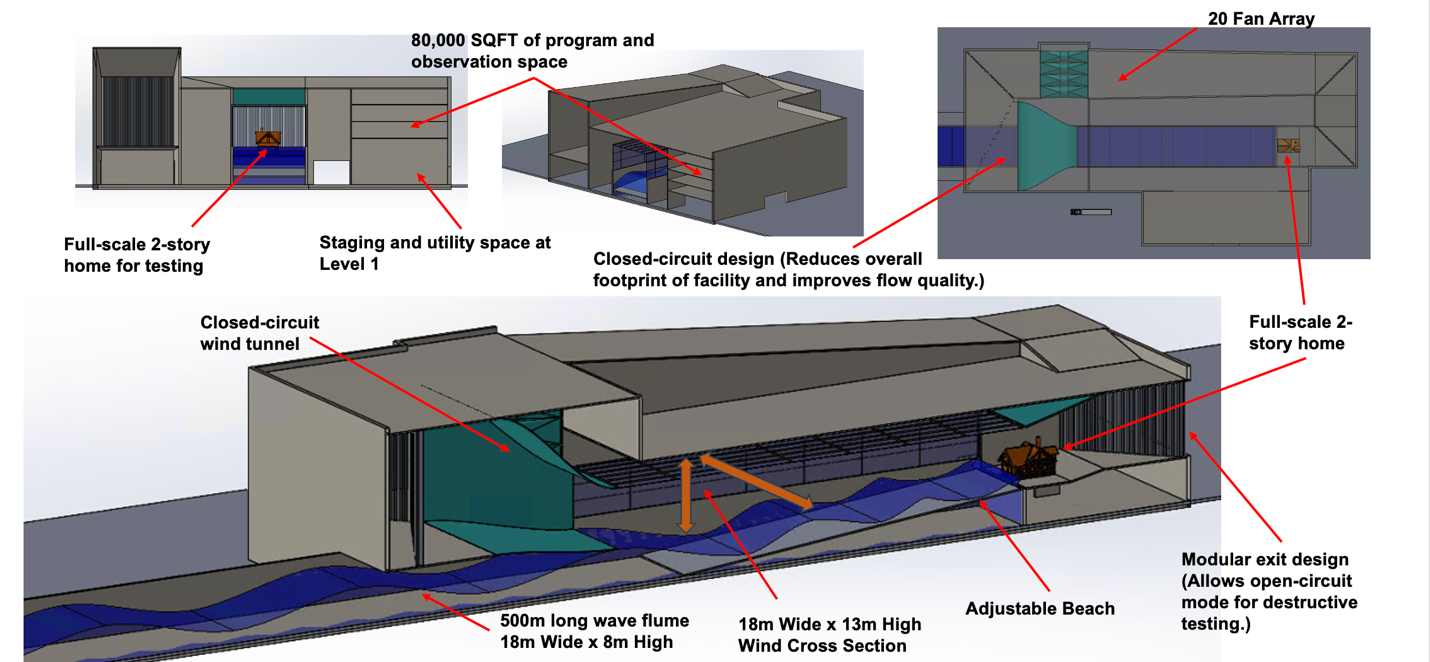
NICHE is expected to be the world’s largest wind-wave facility, capable of generating 200 MPH hurricane winds and 16-foot-high waves, in a flume the length of 10 Olympic-size swimming pools. No other facility comes close to producing wind and waves of such magnitudes. In the NICHE laboratory, researchers will be able to study wind and waves concurrently, as well as separately when required.
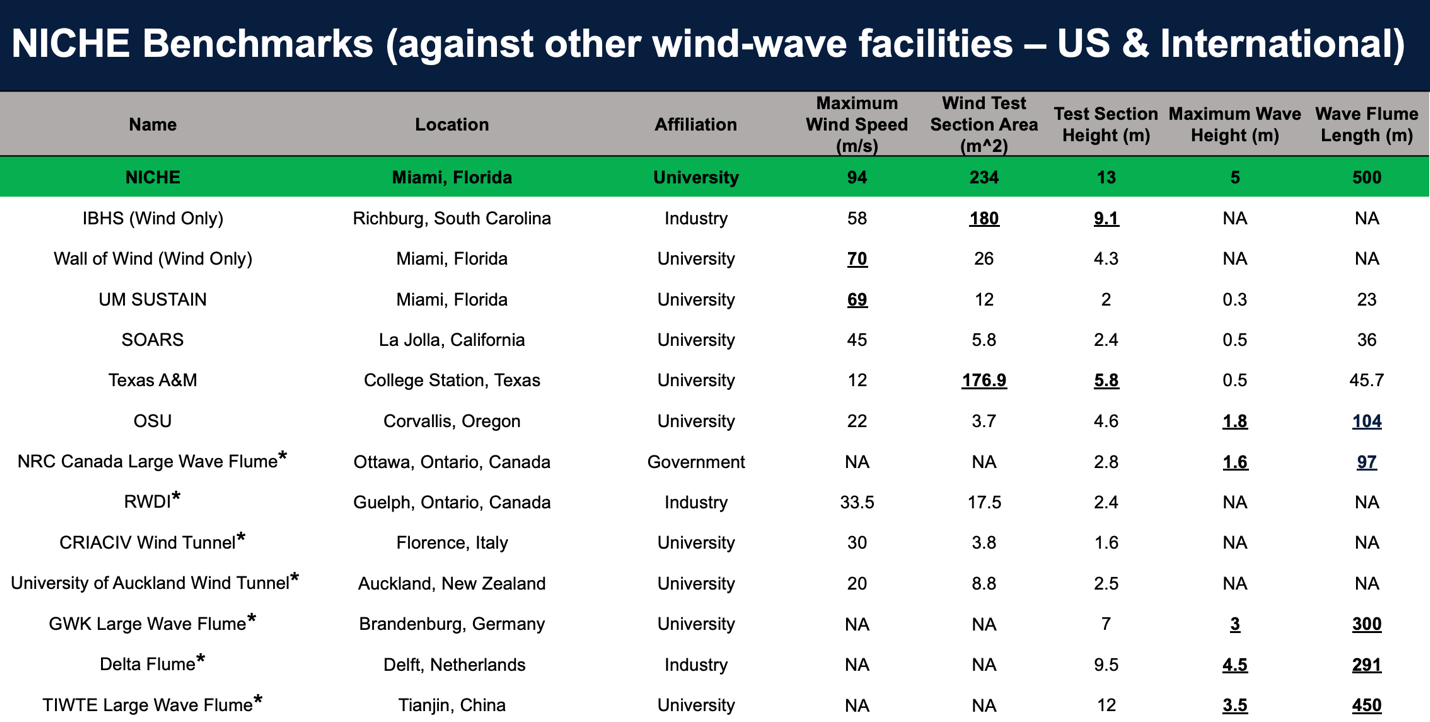
The full-scale NICHE will be the largest wind-wave facility in the world. (Source: NICHE)
Using feedback received from an NSF site review panel, the NICHE Advisory Board, and the NICHE Technical Review Committee, the NICHE design team is in the process of finalizing the facility scope. To ensure the highest flexibility in research capabilities, the NICHE science team is communicating with additional stakeholders and user groups to determine the preferred set of capabilities and which existing synergies can be leveraged in NICHE’s design. Current plans are to construct the NICHE facility in South Florida, in the Miami area. Site selection will be finalized as the design parameters become available.
Physical Testbeds
Data used for designing the full-scale NICHE comes from physical testing taking place at multiple Physical Design Testbeds, called PDTs. PDT testing enables the NICHE team to address and formulate the outstanding scientific and technical requirements associated with constructing this massive new wind-wave research lab.
Several PDTs are located at existing facilities, including the wind tunnel at University of Florida (UF) and the wind-wave lab at University of Miami (UM). In addition, the team is using several new or newly upgraded PDTs. These include a wind-only facility under construction at Florida International University (FIU); a significant upgrade at the Oregon State University (OSU) Large Wave Flume facility; as well as an upgrade to University of California San Diego's (UCSD) Scripps Institute wave lab. The upgrades to the OSU and UCSD are funded by the NICHE planning award, as is the new construction at FIU – which is also partially funded by FIU.
“The PDTs are critical in informing NICHE design parameters,” said Chowdhury. “For example, the tests at U Miami will help determine the effect of seawater versus freshwater spray on structures, while the OSU and UCSD tests will be answering important practical questions about design parameters for simulating wind and wave interactions.”
FIU’s wind-only testbed. In August 2024, construction began on the Wind Only Physical Design Testbed (WOPDT) on the FIU campus.
“We are pleased to have the WOPDT underway,” said Chowdhury. “This wind tunnel, designed specifically with NICHE capabilities in mind, is critical to advancing the full-scale design of this major new facility. It will also help to assess the reconfigurable open- and closed-circuit modes of the NICHE wind generation system.”
This testbed will have a single NICHE fan, capable of blowing winds at 200 MPH. The design team is eager to study machinery durability, efficiency, and noise level. Importantly, a louver system (tested previously at a lower wind speed in the UF PDT) will be tested at the WOPDT at higher wind speed and will be capable of generating transient winds like in tornadoes and downbursts.
In September 2024, workers began installing wind components on the site’s slab. The team expects experiments to begin early in 2025.
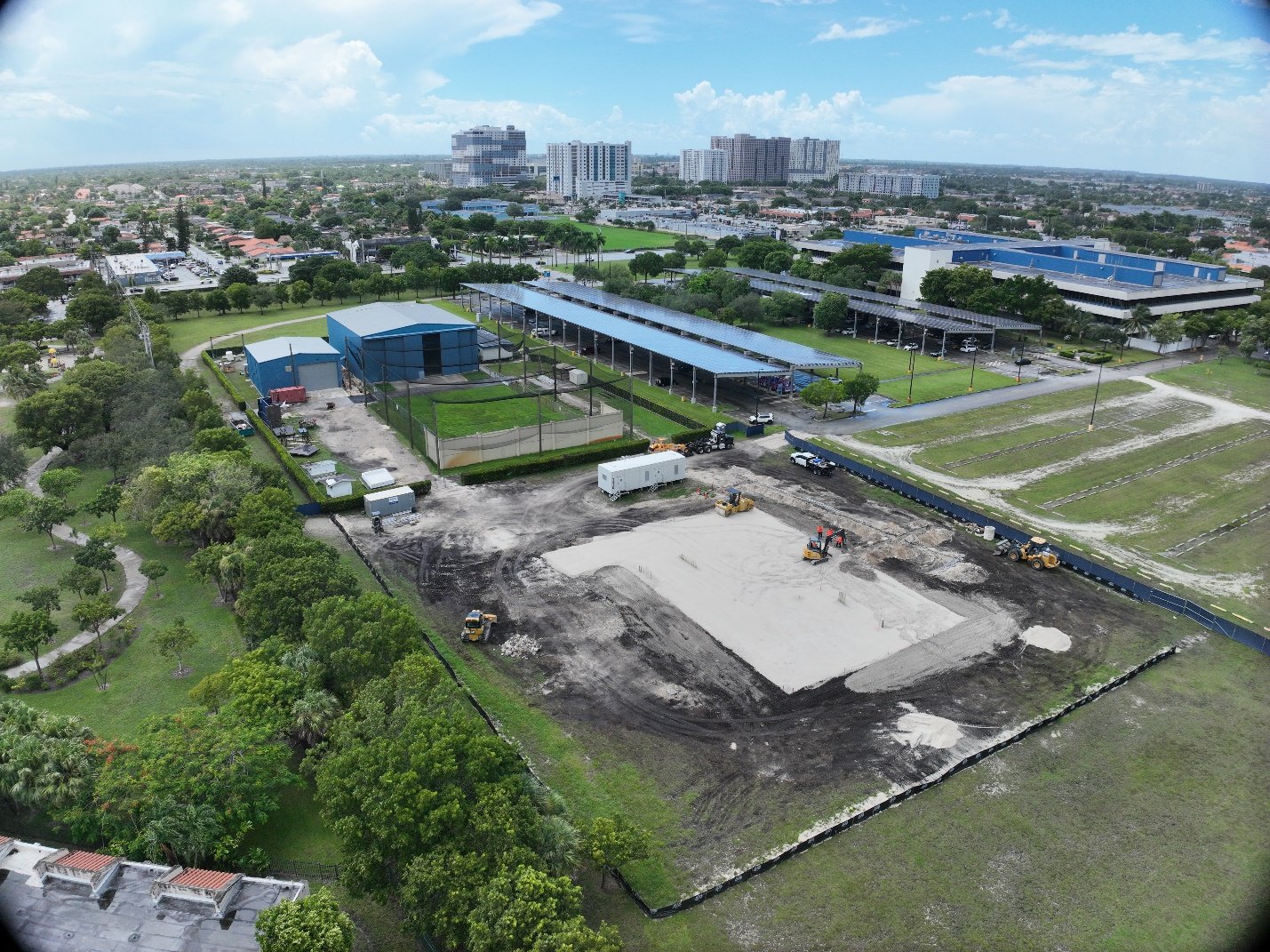
FIU Wind-only PDT site, looking SW toward the Wall of Wind facility and the FIU Engineering Campus, August 2024. (Image: NICHE)
OSU wind-and wave testbed. An upgrade to the Oregon State University Large Wave Flume (LWF) laboratory, completed in late 2023, enabled this facility to accommodate high speed fans for conducting wind-and-wave testing. Tests conducted in January 2024 enabled the NICHE team to advance its testing program while awaiting an upgrade to the wind-water laboratory at UC San Diego, an additional PDT.
“It was exciting to see the LWF as a wind-wave facility,” said Pedro Lomonaco, director of the O.H. Hinsdale Wave Research Laboratory, co-PI of the NHERI OSU facility, and co-PI for NICHE. “The fan upgrade is in line with our long-term plans for the Hinsdale Laboratory, becoming a new facility capable of multi-hazard research. The OSU lab has contributed significantly to the design of the full-scale NICHE, addressing scale effects, wind-wave generation, and headspace.”
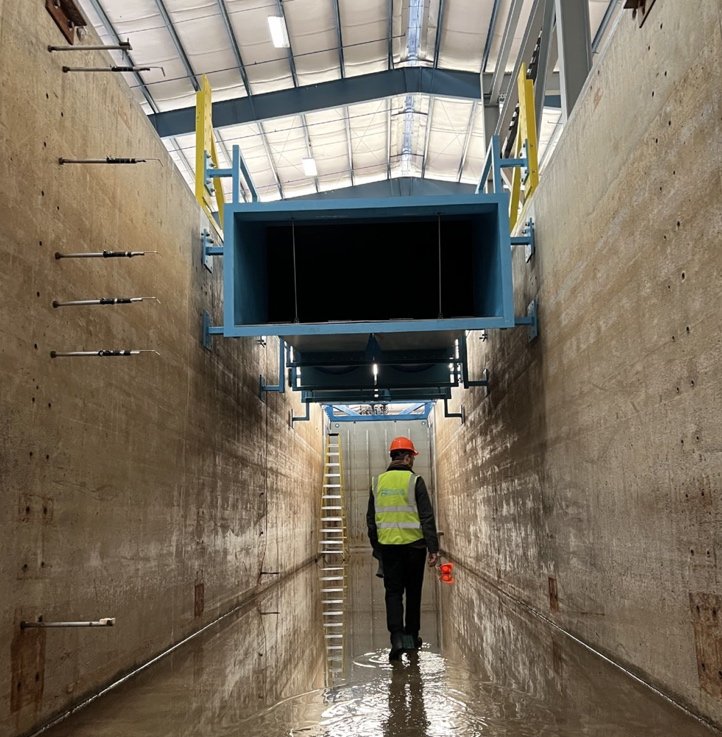
Mid-speed wind generation equipment and wind sensors installed in OSU Large Wave Flume. (Image: NICHE)
Computational modeling. Using OSU’s new capability as a wind-wave facility, the NICHE team has new opportunities to validate computational models of the wind-wave interaction at a larger scale than previously possible. The validated model can then be used to investigate the effect of important design parameters, such as the height and length of the wind channel over the wave flume.
"Initial validation of the computational models used experiments in smaller-scale facilities, said Catherine Gorlé, associate professor of engineering at Stanford University and co-PI for NICHE. “The experimental program at OSU enables us to investigate the accuracy of the models at a larger scale, which will then support using the simulations to inform the full-scale NICHE facility design. In short, the computational modeling program will tell us how we can design a facility that produces realistic wind-wave conditions.”
The computational fluid dynamics (CFD) team continues to work on their model validation against the OSU experiments while simultaneously performing parametric studies to inform the design of NICHE. Data derived at the UC San Diego and University of Miami is also informing the NICHE CFD program. A future goal is using the model to simulate the flow in the larger NICHE facility.
UCSD Scripps wind-and-wave testbed. Another testbed is located at the UC San Diego Scripps Ocean Atmosphere Research Simulator, SOARS. This laboratory, which recently underwent a significant upgrade, enables researchers to test wind and wave interaction — with the goal of establishing modeling capabilities of the moving-piston-type wave maker employed by SOARS, using fresh and salt water. This is key to designing the full-scale NICHE. This PDT generates wind speeds between 60 and 100MPH. The second round of experiments, utilizing the higher wind speed upgrades and a foreshore bathymetry to replicate the case of storm surge and coastal wind-wave action, were completed at the end of August 2024.
The testbed at UC San Diego Scripps Ocean Atmosphere Research Simulator, SOARS. Below, looking down the flume during instrumentation setup. Right, looking through the experiment “window” at active waves in the flume. (Images: NICHE)
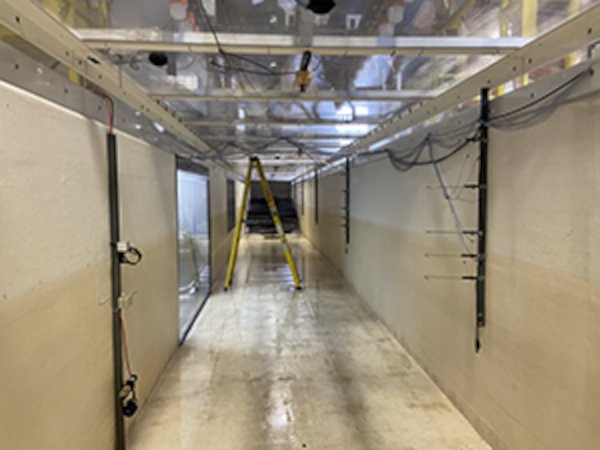


Flow visualization (video still frame) of a vortex created in the UF BLWT with the louver system. (Image: NICHE)
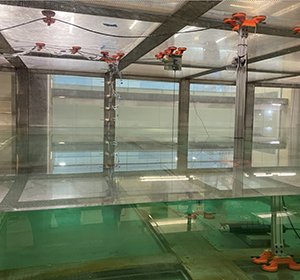
Testbed at University of Miami's SUSTAIN laboratory, showing instrumentation in the tunnel/flume with water during setup. (Image: NICHE)
University of Florida wind-only testbed. At the University of Florida (UF) Boundary Layer Wind Tunnel, physical tests in 2023 focused on creating vortices in the straight-line wind tunnel using two methods: 1) a partial blockage vertical wall, and 2) a set of actuated louvers. The resulting data analysis will inform the full-scale NICHE design for generating transient winds.
The UF physical tests were complemented by computational models to determine the capability of generating translating vortices. These models were able to predict the behavior of generated vortices for both boundary conditions.
U Miami wind-wave testbed. Another NICHE testbed is located at the University of Miami’s SUSTAIN laboratory, a robust, wind-wave-storm simulator facility. The NICHE team’s tests here centered on the combined effects of wind and wave under high-speed wind conditions and using either sea or fresh water. Data captured from these experiments indeed revealed that water management at the higher wind speeds will be a critical factor at the full-scale NICHE facility.
Incorporating convergence
A novel aspect of the NICHE award is its inclusion of a convergence research component, an NSF priority that seeks to address complex problems with a deeply interdisciplinary approach.
In 2020, the NICHE team convened its first multidisciplinary workshop to discuss the sorts of new research potentials the NICHE facility could provide. Participants included engineers, social scientists, economists, computer scientists, as well as representatives from the business and insurance communities. Since then, the NICHE team has held additional workshops, including two this year, to guide the convergent research framework for NICHE — which will include several example testbed communities.
“The goal for a convergence-focused research infrastructure is to enable users to seamlessly integrate field observations and computational models into their experiments at NICHE,” said Tracy Kijewski-Correa, professor of engineering and global affairs at the University of Notre Dame and co-PI for the NICHE award.
NICHE Project Team
- Arindam Gan Chowdhury (PI) Florida International University
- Amal Elawady Florida International University
- Hermann M. Fritz Georgia Institute of Technology
- Catherine Gorlé Stanford University
- Kurtis R. Gurley University of Florida
- Tracy Kijewski-Correa University of Notre Dame
- Frank Lombardo University of Illinois at Urbana-Champaign
- Pedro Lomonaco Oregon State University
- Forrest J. Masters University of Florida
- Jack Puleo University of Delaware
- Kristin Taylor Wayne State University
- John W. van de Lindt Colorado State University
- Paul Vasilescu Aerolab
- Ioannis Zisis Florida International University
“One example of this capability is our testbed communities, locations where we will build a regional computational model of all the buildings and infrastructure, its shoreline, and historical hazard scenarios, and where we have deep relationships with local stakeholders,” said Kijewski-Correa. “These community models will let NICHE users explore how mitigation investments or other interventions could change risks under different hazard scenarios.” Such models also let researchers scale up their work. For instance, a researcher might test a single component or building-level intervention and use the testbed model to demonstrate the impact of implementing that intervention across the whole community.
Another aspect of NICHE is its plan for dedicated research-translation pathways, channels for moving a research project beyond the experimentation phase into real-world usage.
Inspired by work from NHERI Tech Transfer Committee and by their own research, the NICHE team identified four pathways for research translation: codification, commercialization, policy, and practice. “These are an integral part of the NICHE facility, and a novel feature for a laboratory like this,” said Kijewski-Correa. “We’re in the process of building a formal translation process, with user training and partnerships to support each of these pathways.”
NICHE through 2026
When the design team completes its test-bed experiments by early 2025, work begins to outline in detail the specifications for the NICHE facility. When the NICHE planning award is finished in January 2026, the project team will present a robust plan for building the full-scale NICHE, an unprecedented multi-hazard experimental facility with the support of the Major Research Equipment and Facilities Construction (MREFC) program at NSF.
With the NICHE facility, future natural hazards researchers will have the capability to address the complex problems posed by increasingly severe wind-and-water hazards in the U.S. In the meantime, it is exciting to watch progress unfold on the development of a potentially new NSF-funded research facility.





